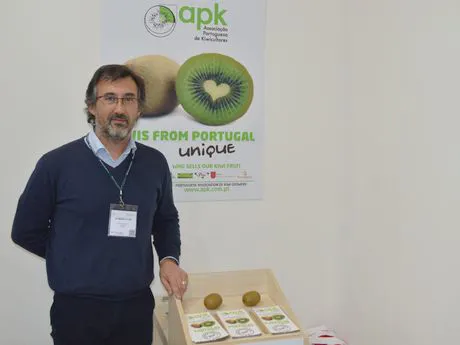The country on the Iberian peninsula has about 2,100 hectares of kiwifruit cultivation. The growers can be found in the area of about 300 kilometres from Spanish Galicia on the northern border of Portugal, and Oeste, the main cultivation area for the Rocha pear. Last year, the harvest amounted to 21,000 tonnes, a 25-per cent decrease compared to the previous season. “The winter was too warm,” Avelino explains. “Due to the lack of low temperatures, production was disappointing.”

Avelino Luis, manager of the Portuguese Association for Kiwifruit Growers (APK).
Extension of yellow kiwifruit season
APK is a non-profit association that brings growers, traders and suppliers in contact with each other. About 30 per cent of the kiwifruit growers is a member of the association, but APK also markets products from non-members. In total, APK markets 80 per cent of the commercial kiwifruit production in Portugal. “The largest part of production consists of green Hayward kiwifruit. Additionally, we see growers planting more yellow kiwifruit, and there is a small production of kiwi berries.”
That increasing interest among kiwifruit growers for yellow kiwifruit coincides with the seasons for the fruit. For green kiwifruit, the harvest is between mid-November and mid-December. The majority of the growers already get the fruit within the first 15 days of the season. “Growers want to stay ahead of the frost, and they want to be sure the fruit has a good brix level.” The harvest of yellow kiwifruit is ahead of the harvest of the green ones. Growers can therefore extend the season with the yellow kiwifruit. “That results in an advantage for labour and infrastructure, because these are not yet used for Hayward then.”
Last year, more than half the harvest was exported, yet kiwifruit can only be found in a limited number of countries. By far the largest part, 97 per cent, is exported to the neighbouring country, Spain. Additionally, there is export to Brazil, Canada and the former colonies of Portugal, such as Angola. “We are looking at possibilities of exporting to Northern Europe,” Avelino continues. The two main reasons for looking at Northern European countries: price and quality. “We have too little production to supply the Asian markets.”
More information:
APK
Avelino Luis
+351 256 336 244
apk@apk.com.pt
www.apk.com.pt
